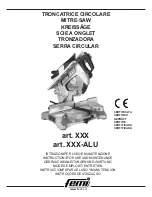
page 4
TOOL ASSEMBLY
CHARGING AND USING BATTERY PACK
Charge your battery pack before using your tool for the first time and
when your tool no longer performs with the power and torque needed for
the job. Full loading capacity of battery pack is only reached after
4 - 5 chargings. Never completely discharge the battery pack. Standard
charging time will vary according to the type of charger you use. The
charging time will also vary depending on the supply voltage and charge
needed. For example, if your battery pack does not require a full charge,
charging time will be less.
FOR SPECIFIC CHARGING INSTRUCTIONS, PLEASE READ THE
CHARGER INSTRUCTION SHEET SUPPLIED WITH YOUR CHARGER.
Battery packs are affected by temperature. Your battery pack will
perform best and have longest life if it is charged when the temperature
is between 60°-80°F (15°-27°C). Do not charge in temperatures below
40°F (5°C) or above 105°F (40°C). Under these conditions, capacity will
be reduced. See “Maintenance”.
Charge only
MILWAUKEE 12, 14.4 and 18
Volt battery packs in chargers. Other types
of batteries may explode causing personal
injury and damage.
WARNING!
Removing Battery Pack from Tool (Fig. 1)
Push in the release buttons and remove the battery pack.
Inserting Battery Pack into Tool
To insert the battery pack into the tool, push in the release buttons and
slide it into the body of the tool.
Selecting a Blade
The Quik-Lok
®
Blade Clamp can be used with all 1/2" shank universal
Sawzall
®
blades. Use
MILWAUKEE High Performance Super Sawzall
®
blades for best performance. When selecting a blade, choose the right
type and length.
Many types of blades are available for a variety of applications: cutting
metal, wood, nail-embedded wood, scroll cutting, roughing-in, and con-
tours.
Many lengths are also available. Choose a length long enough to extend
beyond the shoe and your work throughout the stroke.
Do not use blades
less than 3-1/2" long since they won't extend beyond the shoe
throughout the stroke.
For best performance and longest life, see “Accessories” to select the
best blade for the job.
Installing and Removing Blades
Quik-Lok
®
Blade Clamp (Fig. 2)
Remove battery pack before changing blades. Make sure the spindle and
blade clamp areas are clean. Metal chips and sawdust may prevent the
Quik-Lok
®
Blade Clamp from clamping securely.
1.
Depending on the job, the blade may be inserted with the teeth fac-
ing up or down. To install a blade, twist collar in the direction of the
arrow while inserting the blade into the clamp until the tang butts
against the collar.
2.
Release collar and the spring loaded mechanism will clamp the blade
firmly in place.
3.
Twist collar in the opposite direction of the arrow to ensure that the
blade is locked into the clamp.
4.
Tug on blade to make sure it is securely locked in place.
5.
To remove a blade, twist collar in the direction of the arrow while
pulling on the blade. Be careful when handling hot blades.
Quik-Lok
®
Blade Clamp Maintenance
•
Periodically clean dust and debris from the Quik-Lok
®
Blade Clamp
with dry compressed air.
•
If the collar resists twisting, twist the collar back and forth to shake
debris loose.
•
Periodically lubricate Quik-Lok
®
Blade Clamp with a dry lubricant such
as graphite.
Removing broken blades from the Quik-Lok
®
Blade Clamp
Remove battery pack before removing blades. Broken blades can be re-
moved by the following methods.
•
Point the tool downward, twist the collar, and shake the tool up and
down (
DO NOT
turn the tool on while your fingers are holding the
blade clamp open). The shank of the broken blade should drop out of
the clamp.
•
If shaking the tool doesn't work...
In most cases, a corner of the broken blade will extend beyond the
blade clamp. Simply twist the collar and pull the broken blade out of
the clamp by this corner.
•
If the broken stub doesn't extend far enough to be grabbed by its
corner, use a thin blade with small teeth (such as a metal cutting
blade) to hook the blade that is jammed in the clamp while twisting
the collar and pull it out.
To reduce the risk of injury, always lock trigger or
remove battery pack before changing or removing
accessories. Only use accessories specifically
recommended for this tool. Others may be
hazardous.
WARNING!
Fig. 1
Inserting a battery pack
Removing a battery pack
Blade
Collar
Fig. 2
Summary of Contents for 6515-20
Page 23: ...page 23...





































